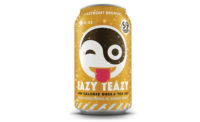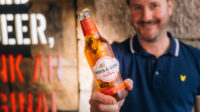Within the craft beer market, seasonal brews and IPAs have shared the limelight. But lately, consumers and analysts are seeing another beer style take the spotlight: session IPAs.
Although session IPAs are not new to the craft beer market, the style has gained more attention as of late and even has motivated more brewers to add the style to their portfolio.
Patrick Livingston, director of client insights of beer, wine and spirits for Chicago-based Information Resources Inc (IRI), notes that the market research firm doesn’t define session beers as a style or segment overall because it can cross into various segments and styles. However, session beers typically will feature a lower alcohol-by-volume (ABV) content and a lighter body profile, he adds.
“With a consumer product trend toward ‘better-for-you’ alternatives, these attributes may appeal to consumers looking for healthier options,” Livingston says.
Nathan Greene, consulting analyst for New York-based Beverage Marketing Corporation (BMC), explains that labeling a brew as sessionable primarily operates as a marketing device; however, he sees the potential for session IPAs to reach more consumers.
“The rise of session beers, and more specifically session IPAs, are at least indirectly a response to the mass popularity of IPAs in general in that they address many consumers concerns regarding traditional IPAs such as high-alcohol content, feeling full following only a drink or two, and potentially high relative calories etc.,” he says. “There are certainly two current major threads in craft which diverge based upon sessionability, most growth and [new product development] within the segment is either coming from incredibly ‘heavy’ beers such as hazy IPAs and pastry stouts or lighter craft options, which fall under the ‘session beer’ segment. What is especially interesting, yet should not come as surprise, is that many of the highest growth breweries, both regional and local, are very active in both spaces.”
Leading the session IPA sub-segment is Founders’ All Day IPA. Citing IRI data for multi-outlet/convenience stores, Livingston reports that the craft brew accounts for nearly 70 percent of market share based on case sales among session IPAs. Additionally, Founders’ All Day IPA sales grew more than 50 percent in the latest 13-week time period compared with 2017, he says.
Livingston highlights that data like this illustrates the potential of the session IPA sub-segment. “Brewers may be interested in broadening their product portfolio, and the Session IPA style may offer additional consumer benefits that are not found in other products in the brewer’s line up,” he says. “In the latest 13 weeks, there were 62 Session IPA brands introduced to the U.S. market. The Session IPA innovation is led by Boston Beer Co.’s Sam Adams Rebel Anytime Session IPA.”
The impact also can be seen through recent performance throughout the session IPA sub-segment of craft beer.
“Session IPAs sold $5.58 million and grew 38.5 percent in dollar sales in the off-premise multi-outlet/convenience store market in the latest 13 weeks,” Livingston explains. “Several leading brands, including Golden Road Wolf Pup Session IPA and Terrapin Recreation Session IPA, are posting triple-digit growth rates in the off-premise [market]. Founder’s All Day IPA has the Top 3 packages, including the 15 pack [of] 12-ounce can, which is growing 44.4 percent, and the recently introduced single 19-ounce can growing at a strong rate, especially in convenience stores.”
What also has curried favor with consumers and session IPAs are the value propositions that craft brewers have attached the sub-segment.
“[C]raft breweries often use some form of a value proposition in order to attract consumers of domestics and differentiate from those products,” BMC’s Greene says. “By pricing session beers between that of traditional craft and mass-market domestics the brewers create an opportunity for consumers to ‘trade-up’ to a product, which will often be perceived as better tasting and therefore higher quality than a traditional light lager, combined with a potentially more compelling brand story.”
Greene thinks that session IPAs can be a solution to support volume growth, but offers cautions on its pricing strategy for the future. “Many of [session IPAs] are sold in larger pack types, with 15-packs of cans being most popular,” he says. “However, in a cautionary sense, volume growth coming from the lower end of the price spectrum for the craft category could lead to a deceleration in dollar growth for the category as a whole. This could especially occur if consumers become too widely accustomed with access to craft beer at a lower price point and therefore raising the potential consumers baulk at higher-priced offerings.”
Yet, analysts note that craft brewers must continue to embrace new innovations and opportunities to help the beer segment return to accelerated growth.
“The craft segment is absolutely in the middle of a reshaping into a new phase of its evolution as a key part of the beer industry,” Greene says. “Based on some definitions of craft, the category has eclipsed 15 percent of total volume and still growing, albeit at a slower pace. Today craft growth is driven primarily by local players through continuous innovation, (in both of the previously mentioned threads of the segment) along with some key large players who have found ways to resonate with consumers despite reaching scale (i.e. Dogfish Head & Founders).
“However, the advent of the localization of the category has led many, including BMC, to question whether a true national craft brand will remain sustainable in the long term,” he continues. “There is a large risk that there will be a recurring turnover in which brands reach scale only to be eclipsed by the new ‘hot’ up-and-coming brand. This is driven by the simple fact that the craft segment will always remain an area for continuous experimentation even by the most experienced consumers.”







